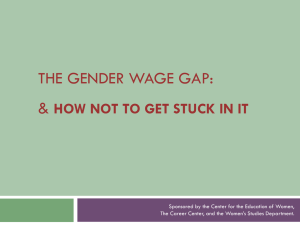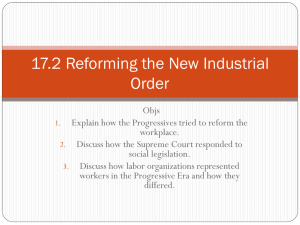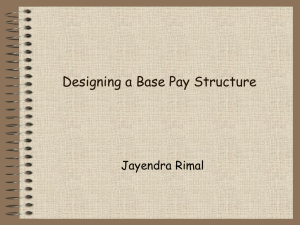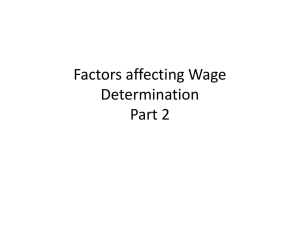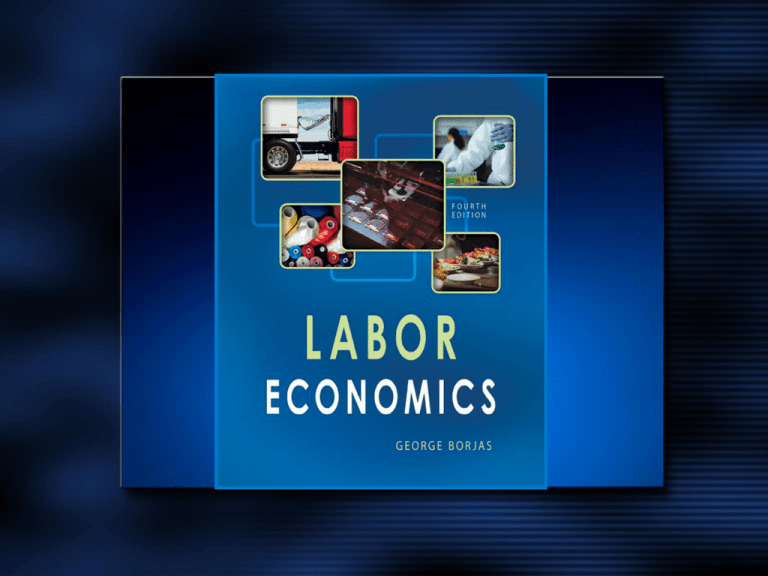
Chapter 8
The Wage Structure
McGraw-Hill/Irwin
Labor Economics, 4th edition
Copyright © 2008 The McGraw-Hill Companies, Inc. All rights reserved.
8-3
Introduction
• Some workers will earn more than others
- Productivity differences
- Rate of return to skills will differ
• This chapter considers the factors that contribute to the shape of
the wage distribution
8-4
The Earnings Distribution
• The wage distribution is positively skewed (long right tail)
• A small percent of workers earn disproportionately large shares
of the rewards for work
8-5
The Wage Distribution in the United
States, 2002
18
15
Percent
12
9
6
3
0
0
500
1,000
1,500
2,000
Weekly Earnings
2,500
3,000
8-6
Facts About the Earnings Distribution
• Wage differentials exist due to
- Human capital investments that vary from worker to worker
- Age (young workers are still accumulating human capital,
older workers are collecting returns from earlier
investments
• There is a positive correlation between ability and human
capital investments, which “stretches out” wages in the
population
8-7
Income Distribution When Workers
Differ in Ability
Rate of
Interest
MRRL
MRR*
MRRH
r
HL
H*
HH
8-8
The Lorenz Curve and the Gini
Coefficient
B
1
0.8
Share of income
Perfect-equality
Lorenz curve
0.6
0.4
Actual
Lorenz curve
0.2
A
C
0
0
0.2
0.4
0.6
Share of households
0.8
1
The “perfect-equality”
Lorenz-curve is given
by the line AB,
indicating that each
quintile of households
gets 20 percent of
aggregate income, while
the Lorenz curve
describing the actual
income distribution lies
below it. The ratio of
the shaded area to the
area in the triangle ABC
gives the Gini
coefficient.
8-9
Changes in the Wage Structure – the
1980s
• The wage gap between those at the top of the wage distribution
and those at the bottom widened dramatically
• Wage differentials widened among education groups,
experience groups, and age groups
• Wage differentials widened within demographic and skill
groups
8 - 10
Earnings Inequality for Full-Time, YearRound Workers, 1963-2003, Gini Coefficient
0.45
Gini Coefficient
0.4
Men
0.35
0.3
Women
0.25
0.2
1960
1970
1980
1990
Year
2000
2010
8 - 11
Earnings Inequality for Full-Time, YearRound Workers, 1963-2003, 90-10 Wage Gap
450
400
Percent wage gap
Men
350
300
Women
250
200
150
1960
1970
1980
1990
Year
2000
2010
8 - 12
Earnings Inequality for Full-Time, YearRound Workers, 1963-2003, 50-10 Wage Gap
150
Percent wage gap
130
Men
110
Women
90
70
50
1960
1970
1980
1990
Year
2000
2010
8 - 13
Wage Differential Between College Graduates
and High School Graduates, 1963-2001
100
90
Percent
80
70
60
50
40
1960
1970
1990
1980
Year
2000
2010
8 - 14
Why Did Wage Inequality Increase?
• No single factor explains the changes
• The increase in inequality seems to be caused by concurrent
changes in economic “fundamentals” and labor market
institutions
8 - 15
Changing the Wage Structure
• Decrease in supply of skilled workers will cause widening of
wage gap
• Increase in demand for skilled workers will cause widening of
wage gap
8 - 16
Possible Factors That Widened the Wage Gap
• Globalization of U.S. economy
• Demand for skilled workers increased by more than the demand
increase for unskilled workers
• Increased physical capital helped to increase the productivity of
skilled workers
• Weakened bargaining power of unions could be from the
relative shift in demand for skilled labor
8 - 17
Changes in the Wage Structure Resulting
from Shifts in Supply and Demand
Relative Wage of
Skilled Workers
S0
r1
S1
C
r0
A
D1
B
D0
p0
p1
The downward-sloping demand curve
implies that employers wish to hire
relatively fewer skilled workers when the
relative wage of skilled workers is high.
The perfectly inelastic supply curve
indicates that the relative number of skilled
workers is fixed. Initially, the labor market
is in equilibrium at point A. Suppose the
relative supply of skilled workers increased
to S1. The rising relative wage of skilled
workers can then be explained only if there
was a sizable outward shift in the relative
demand curve (ending up at point C).
Relative Employment
of Skilled Workers
8 - 18
The Earnings of Superstars
• Superstar phenomenon – a few persons in some professions
earn very high salaries and seem to dominate their field
• This suggests that even if a job is the same, different people
bring different skills to the same job
8 - 19
Inequality Across Generations
• There is a correlation between the skills of parents and their
children
• High-income parents will typically invest more in the education
of their children
• There is a tendency for income differences across families to
get smaller over time (“regression toward the mean”)
8 - 20
The Intergenerational Link in Skills
The slope of the regression line
linking the earnings of the
children and the earnings of the
parents is called an
intergenerational correlation. If
the slope is equal to 1, the wage
gap between any two parents
persists entirely into the next
generation, and there is no
regression toward the mean. If
the slope is equal to 0, the wage
of the children is independent of
the wage of the parents, and
there is complete regression
toward the mean.
Earnings of
Children
A, Slope = 1
C, Slope is between 0 and 1
B, Slope = 0
45
Earnings of Parents
8 - 21
Social Capital
• The quality of the environment where a child grows up helps
determine human capital
• There is evidence that varied factors influence a child’s level of
human capital
- Quality of neighborhood
- Importance of religious organizations
- Socioeconomic background of classmates
8 - 22
End of Chapter 8




